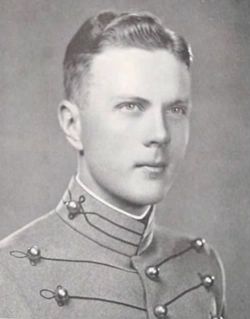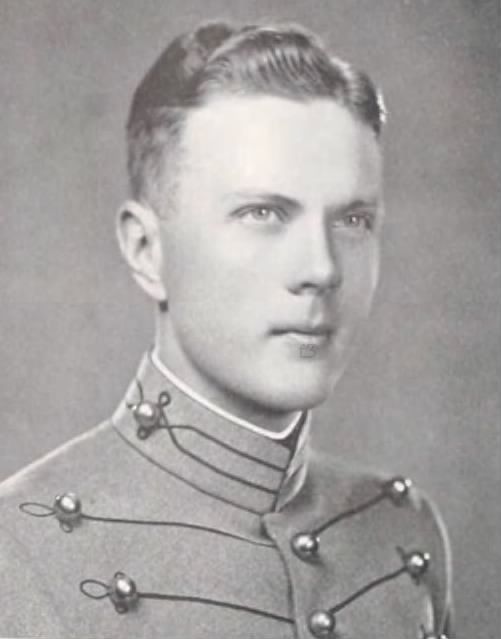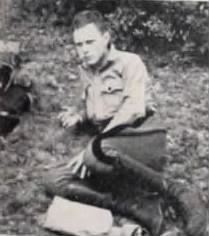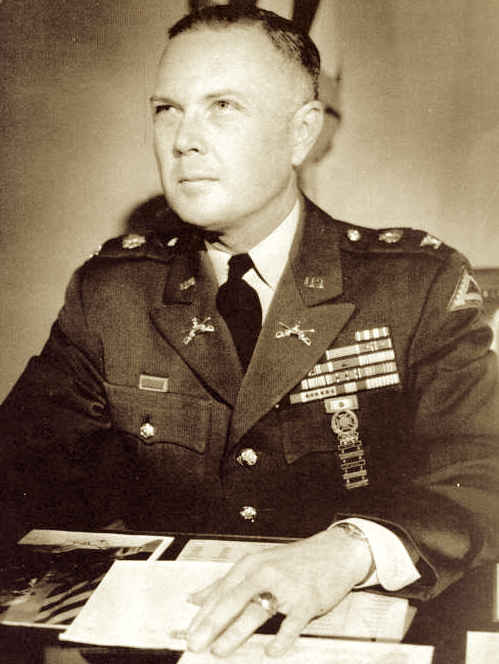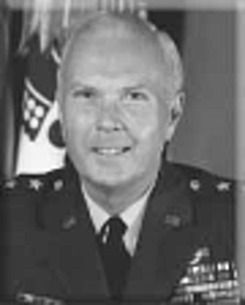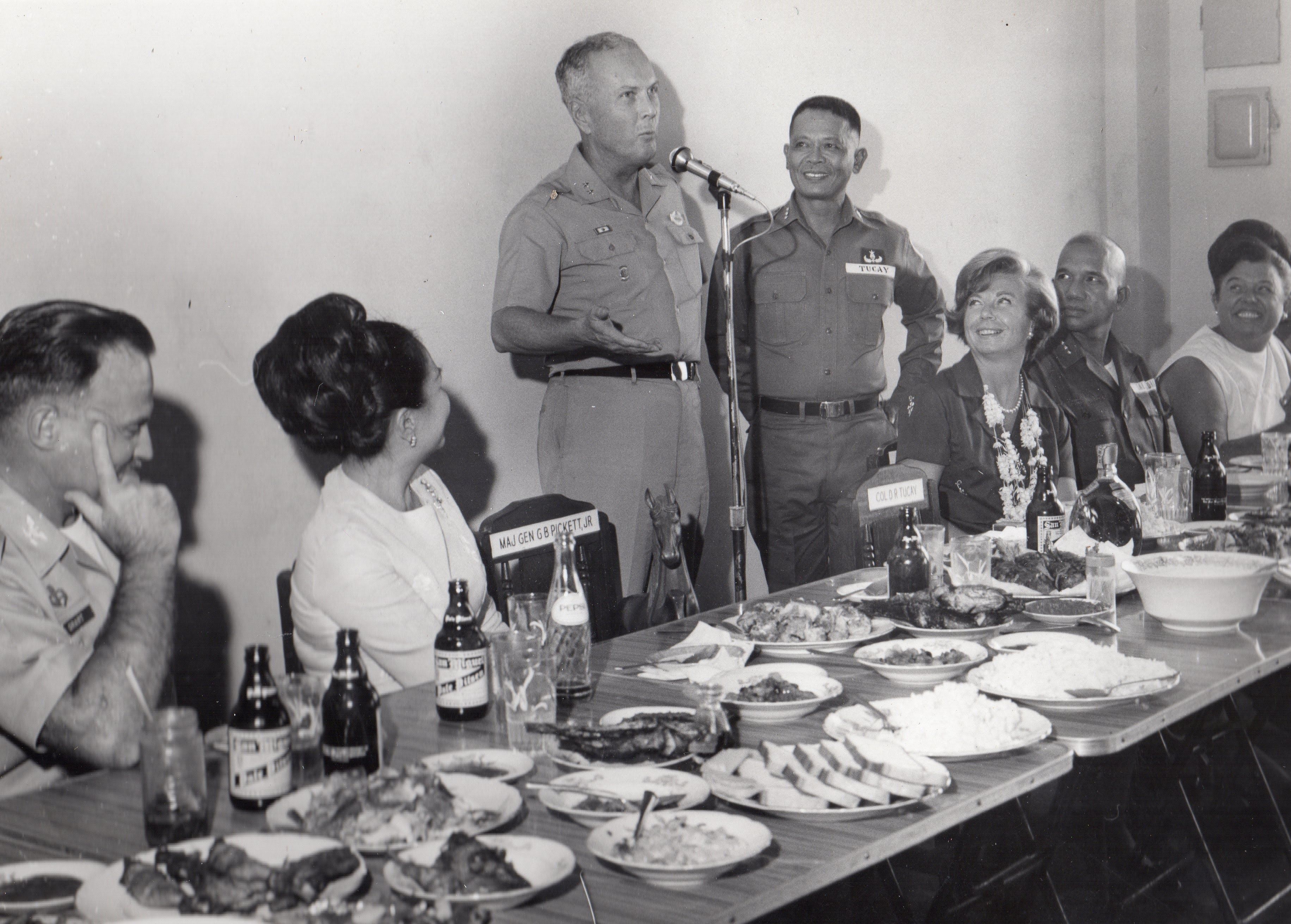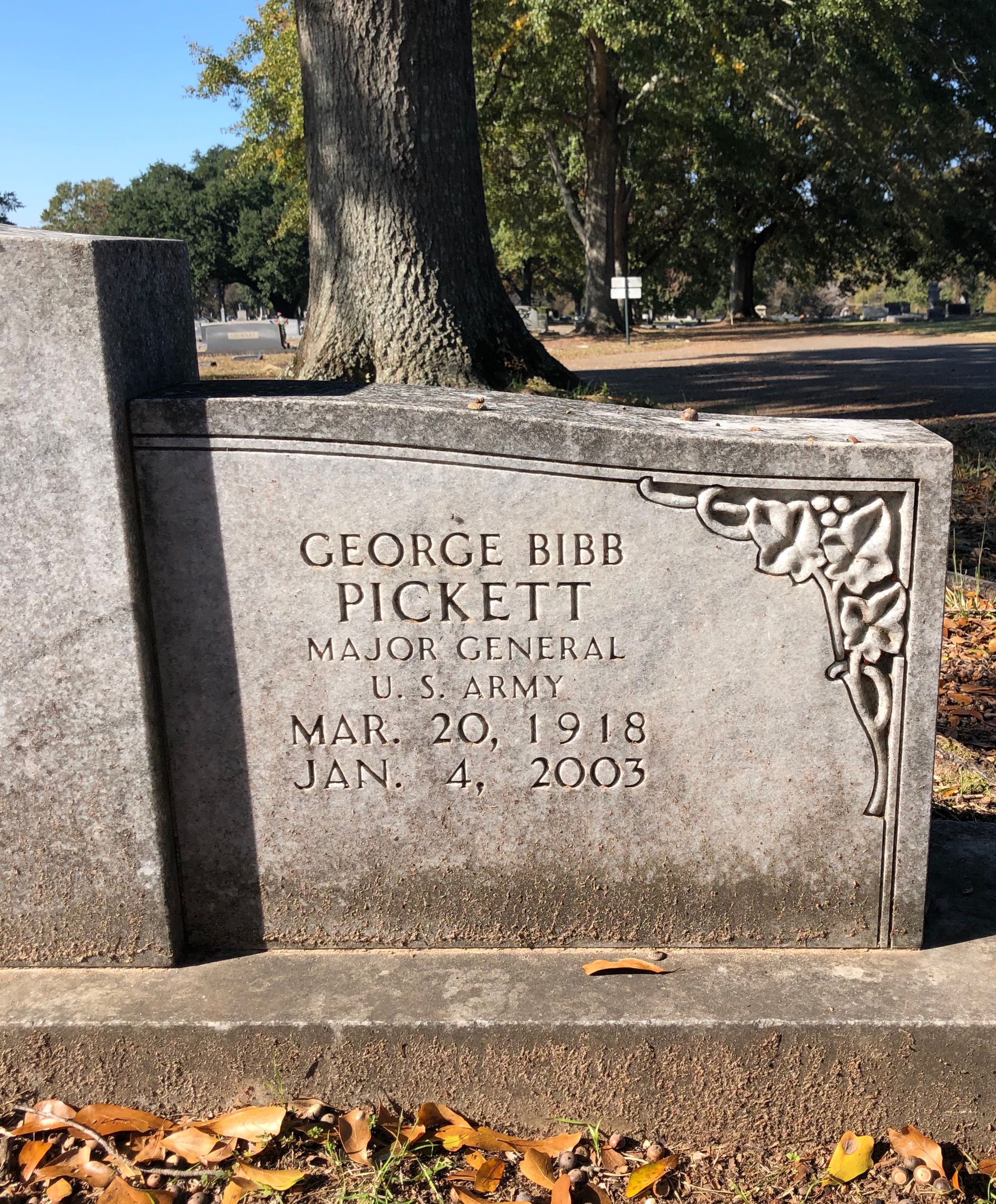George Bibb Pickett, Jr., was born in Montgomery, AL, with a proud pedigree, being a collateral descendant of William Wyatt Bibb, the first governor of Alabama, and of George E. Pickett, of Gettysburg fame. Shortly after his graduation in 1936 from Tennessee Military Institute, George was awarded a surveyor's license and joined his father's business, working as a civil engineer. In 1937, he received an appointment to both the Naval and Military academies. In fact, he was en route to the Naval Academy when his West Point appointment arrived. His mother reached him by telegram with the news he need not disembark in Annapolis but could continue on to West Point, his first choice. He graduated in 1941 and, in December, married Beryl Robinson, a native New Yorker.
George began his military career in the 6th Armored Infantry Division. By 1945, he had been promoted to the rank of lieutenant colonel and, as commander of a battalion of the 16th Armored Division, was GEN Patton's youngest battalion commander. While serving with Patton's forces, he received a Bronze Star for Valor and a Silver Star. Following WWII, George remained a battalion commander with the occupation forces until 1947, when he joined the faculty at the Infantry School at Ft. Benning, GA, serving as an instructor in armor tactics from 1947—50. He also gained a reputation as a writer after his first article, "The Regimental Tank Company," was published in The Infantry Journal in June 1950. Other articles appeared in The Armed Forces Journal, Army Magazine, Armor Magazine, Cavalry Journal, Military Review, and The American Rifleman.
With the South Korean invasion in July 1950, George joined IX Corps as its armor officer and served in Korea until November 1951, earning a Legion of Merit for exceptionally meritorious service. Following the Korean conflict, George became the first senior advisor to the Japanese Military and Naval Academy. While serving in Tokyo, tragedy struck his family when his young son, "Pick," was killed in an automobile accident.
From 1953-56, George served as assistant G-3 with the Fourth Army, Ft. Sam Houston, TX, responsible for developing new concepts of organization and employment of the Armored Division, thereby gaining considerable experience in combat developments. While at Ft. Sam Houston, he also volunteered as an instructor for a chapter of the National Rifle Association and found the time to author more professional articles. George attended the Armed Forces Staff College in 1956, was promoted to colonel, and remained at the college as an instructor in the Research and Development Division until August 1959. During his tenure at the Staff College, he co-authored the book The Joint and Combined Officers Manual, published by Stackpole Company in 1959. Shortly after publication, President Eisenhower wrote a letter to the publisher, stating the text "filled a need in professional military literature."
After graduating from the National War College in Washington, DC, George became the 49th commanding officer of the 2d Regiment of the Dragoons, later designated the 2d Armored Cavalry Regiment, with headquarters in Nuremberg, Germany, serving until July 1963. As such, he was responsible for surveillance and observation of large segments of the East German and Czech borders. Having accepted the surrender of many of the same towns and villages in the region in April 1945, he now returned to defend that area. In 1963, he was promoted to brigadier general and appointed Chief of Staff, Combat Developments Command, Ft. Belvoir, VA.
In 1966, George was promoted to major general and took command of the 2d Infantry Division in Korea, where he was awarded the Medal of Highest Honor of Kyung Hee University, Seoul, for his contributions to Korean-American relations.
In May 1967, he assumed the duties of vice director for Operations, J-3, Office of the Joint Chiefs of Staff. Thereafter he served as Chief, Joint U.S. Military Advisory Group to the Republic of the Philippines. For his outstanding service, he was awarded the Republic of the Philippines Legion of Honor. His final posting was as deputy commanding general, Third Army. He retired in March 1973.
George and his family settled in his childhood hometown, Montgomery, AL. Not known to be sedentary, George returned to work for the National Rifle Association as a field representative. He also joined the staff of the local newspaper, the Montgomery Advertiser, serving as a military columnist. In addition, he found time to nurture his love of military history and earned a local and regional reputation as a lecturer on military affairs. George served his community as a member of the Montgomery Kiwanis Club, The Old South Historical Society, the West Point Society of Alabama, and Sons of the American Revolution. His outstanding and noble service to his country was recognized by the state of Alabama on the occasion of his 79th birthday, when the legislature and governor proclaimed Resolution HJR 227 in his honor. He was also inducted into the Alabama Military Hall of Honor in 1999.
George lost his wife Beryl to cancer and, in 1981, married Rachel Copeland Peeples, an Air Force widow with four children. George died peacefully at age 84 and is survived by his wife, four children, four stepchildren, six grandchildren, three step-grandchildren, and five great-grandchildren. George's grandson, James Pickett, a cadet in the Class of '07, is continuing in the family tradition.
George Bibb Pickett, Jr., was born in Montgomery, AL, with a proud pedigree, being a collateral descendant of William Wyatt Bibb, the first governor of Alabama, and of George E. Pickett, of Gettysburg fame. Shortly after his graduation in 1936 from Tennessee Military Institute, George was awarded a surveyor's license and joined his father's business, working as a civil engineer. In 1937, he received an appointment to both the Naval and Military academies. In fact, he was en route to the Naval Academy when his West Point appointment arrived. His mother reached him by telegram with the news he need not disembark in Annapolis but could continue on to West Point, his first choice. He graduated in 1941 and, in December, married Beryl Robinson, a native New Yorker.
George began his military career in the 6th Armored Infantry Division. By 1945, he had been promoted to the rank of lieutenant colonel and, as commander of a battalion of the 16th Armored Division, was GEN Patton's youngest battalion commander. While serving with Patton's forces, he received a Bronze Star for Valor and a Silver Star. Following WWII, George remained a battalion commander with the occupation forces until 1947, when he joined the faculty at the Infantry School at Ft. Benning, GA, serving as an instructor in armor tactics from 1947—50. He also gained a reputation as a writer after his first article, "The Regimental Tank Company," was published in The Infantry Journal in June 1950. Other articles appeared in The Armed Forces Journal, Army Magazine, Armor Magazine, Cavalry Journal, Military Review, and The American Rifleman.
With the South Korean invasion in July 1950, George joined IX Corps as its armor officer and served in Korea until November 1951, earning a Legion of Merit for exceptionally meritorious service. Following the Korean conflict, George became the first senior advisor to the Japanese Military and Naval Academy. While serving in Tokyo, tragedy struck his family when his young son, "Pick," was killed in an automobile accident.
From 1953-56, George served as assistant G-3 with the Fourth Army, Ft. Sam Houston, TX, responsible for developing new concepts of organization and employment of the Armored Division, thereby gaining considerable experience in combat developments. While at Ft. Sam Houston, he also volunteered as an instructor for a chapter of the National Rifle Association and found the time to author more professional articles. George attended the Armed Forces Staff College in 1956, was promoted to colonel, and remained at the college as an instructor in the Research and Development Division until August 1959. During his tenure at the Staff College, he co-authored the book The Joint and Combined Officers Manual, published by Stackpole Company in 1959. Shortly after publication, President Eisenhower wrote a letter to the publisher, stating the text "filled a need in professional military literature."
After graduating from the National War College in Washington, DC, George became the 49th commanding officer of the 2d Regiment of the Dragoons, later designated the 2d Armored Cavalry Regiment, with headquarters in Nuremberg, Germany, serving until July 1963. As such, he was responsible for surveillance and observation of large segments of the East German and Czech borders. Having accepted the surrender of many of the same towns and villages in the region in April 1945, he now returned to defend that area. In 1963, he was promoted to brigadier general and appointed Chief of Staff, Combat Developments Command, Ft. Belvoir, VA.
In 1966, George was promoted to major general and took command of the 2d Infantry Division in Korea, where he was awarded the Medal of Highest Honor of Kyung Hee University, Seoul, for his contributions to Korean-American relations.
In May 1967, he assumed the duties of vice director for Operations, J-3, Office of the Joint Chiefs of Staff. Thereafter he served as Chief, Joint U.S. Military Advisory Group to the Republic of the Philippines. For his outstanding service, he was awarded the Republic of the Philippines Legion of Honor. His final posting was as deputy commanding general, Third Army. He retired in March 1973.
George and his family settled in his childhood hometown, Montgomery, AL. Not known to be sedentary, George returned to work for the National Rifle Association as a field representative. He also joined the staff of the local newspaper, the Montgomery Advertiser, serving as a military columnist. In addition, he found time to nurture his love of military history and earned a local and regional reputation as a lecturer on military affairs. George served his community as a member of the Montgomery Kiwanis Club, The Old South Historical Society, the West Point Society of Alabama, and Sons of the American Revolution. His outstanding and noble service to his country was recognized by the state of Alabama on the occasion of his 79th birthday, when the legislature and governor proclaimed Resolution HJR 227 in his honor. He was also inducted into the Alabama Military Hall of Honor in 1999.
George lost his wife Beryl to cancer and, in 1981, married Rachel Copeland Peeples, an Air Force widow with four children. George died peacefully at age 84 and is survived by his wife, four children, four stepchildren, six grandchildren, three step-grandchildren, and five great-grandchildren. George's grandson, James Pickett, a cadet in the Class of '07, is continuing in the family tradition.
Family Members
Sponsored by Ancestry
Advertisement
Advertisement
